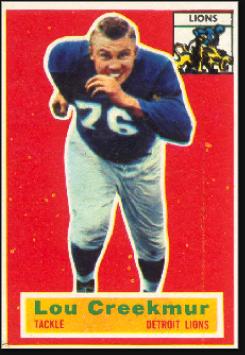
Sport: Football
Born: January 22, 1927
Died: July 5, 2009
Town: Woodbridge, New Jersey
Louis Creekmur was born January 22, 1927 in the Hopelawn section of Woodbridge, NJ. During Lou’s childhood, this area was a football hotbed. Two local semipro teams—the Golden Bears and Greyhounds—engaged in a legendary turf war. Lou grew up watching these battles and dreaming about one day playing in the games himself.
Lou attended Woodbridge High School, later famous for producing Bon Jovi band member Richie Sambura. Lou made the varsity at age 16 and was a dominant high-school player. By his senior year he had grown to 6’3″ and weighed well over 200 pounds. He specialized in clearing a path for the team’s fullback, Tommy Thompson, who went on to star as a defensive captain for the Celeveland Browns. Lou’s stellar play on both sides of the line was enough to earn a scholarship to William & Mary in 1945. W&M grabbed Thompson on the same recruiting trip.
A two-year hitch in the military interrupted Lou’s football playing, but he was back on the field for the Tribe in 1947, by this point standing 6’4″ and weighing 250 pounds. He became a star for W&M during the next three varsity seasons, while finishing up as an undergrad and then taking graduate courses. Lou was actually drafted in 1948 by the AAFC Los Angeles Dons and NFL Philadelphia Eagles, but opted to stay in school. Lou helped William & Mary go 27–10–3 during his four seasons, and led them to their first bowl games, in 1948 and 1949. He also competed for the track team, establishing a school record for the shot put.
After playing in several college all-star games in 1949 and 1950, Lou was selected by the Detroit Lions in the second round of the 1950 NFL Draft. He made the team as a guard his rookie year and was named All-Pro at that position in 1951 and 1952. Lou moved to tackle and was honored as an All-Pro at that position four times between 1953 and 1957.
Lou often joined the defense in short-yardage situations. In 1955, after Les Bingaman retired, the Lions asked Lou to play on the defensive line. He spent one year there and did well enough to be a Pro Bowl pick. In all, he went to the Pro Bowl eight seasons in a row, beginning in 1950.
The Lions were one of the NFL’s elite teams in the 1950s and Lou was a major reason why. Although Detroit fans cheered loudest for the defense, it was the quarterbacking of Bobby Layne and Tobin Rote—and the pass-catching of the backs and wide receivers—that put points on the board. Lou was the star of the offensive line that made this possible. The Lions were NFL champs three times during his years with the club: 1952, 1953 and 1957. Lou was a big part of this success, and one of the players who struck a particular kind of fear into opponents. He had a short temper and often lashed out when he thought an enemy defender tried to hurt Layne or his backfield mates. However, Lou knew how and when to do so when the refs were looking the other way. Not that he didn’t take his share of abuse; Lou played much of his career without a facemask, resulting in 13 broken noses.
Lou retired after the 1958 season. At the time he had never missed a game, playing 165 in a row. Four games into the 1959 campaign, coach George Wilson lured him back. Lou started every game the rest of the way and then called it a career. In 1996, Lou was enshrined in the Pro Football Hall of Fame. Later in life, Lou’s cognitive abilities began to deteriorate. His family suspected that this was due to the countless helmet-to-helmet hits he absorbed during his career. After his death in 2009, an autopsy confirmed the fact that he had been suffering from Chronic Traumatic Encephalopathy (CTE).